Exploring the Cardinal Bird's Dietary Habits and Preferences
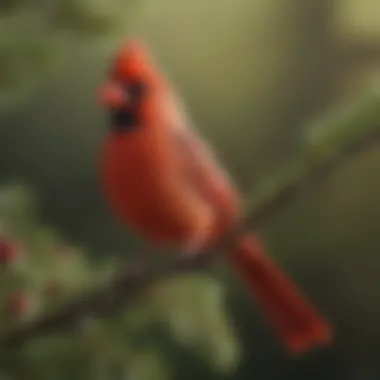
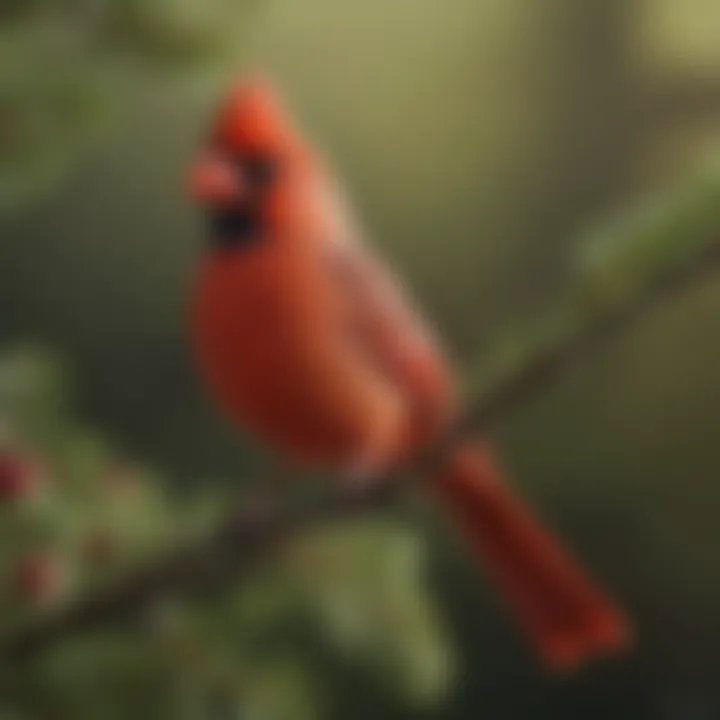
Intro
Cardinals, particularly the Northern cardinal, present an intriguing aspect of avian life. These birds, easily recognized by their striking plumage, have dietary habits that are as colorful as their appearance. Understanding their eating behaviors allows for a broader comprehension of their ecological roles. They primarily thrive in woodlands, gardens, and shrub habitats, often contributing to the spaces they inhabit. Notably, their diet varies seasonally, influenced by the availability of different food sources. This exploration of cardinal eating preferences offers insights that extend beyond mere consumption, highlighting their interaction with the environment and role in local ecosystems.
Nutritional Needs and Preferences
The dietary habits of cardinals, while varied, typically comprise a mix of seeds, fruits, insects, and even small invertebrates. They exhibit a preference for sunflower seeds, berries, and corn, depending on availability. This diet underscores their adaptability to different environments while fulfilling their nutritional requirements. Vitamins and minerals essential for survival drive their food choices. Because they require sufficient energy, cardinals' diets emphasize seeds that provide high energy content.
Cardinals are also known for their unique feeding techniques. They are ground foragers, often scratching the ground to expose hidden seeds and insects. This behavior capitalizes on their habitat, revealing how they optimize their feeding strategies depending on what the location offers.
Seasonal Diet Fluctuations
The variety in the dietary habits of cardinals showcases significant seasonal changes. In winter months, their diet leans heavily toward seeds. During spring and summer, however, they incorporate more insects and blooming fruits. This behavior is not just a survival strategy; it also supports their reproductive needs. Nestlings require protein-rich diets, resulting in parents increasing their insect consumption to sustain their young effectively.
By adjusting their food sources year-round, cardinals maintain a consistent energy intake while ensuring the best nutrition for both themselves and their offspring, essential for the stability of their populations in various ecosystems.
Understanding the cardinal diet not only enlightens bird enthusiasts but also illustrates crucial ecological interactions.
Ecological Implications
On a wider ecological scale, cardinals play a crucial role in seed dispersal. As they consume fruits, they often carry seeds to different locations. This natural behavior encourages the growth of various plant species, contributing to biodiversity. Furthermore, their feeding patterns can impact insect populations, showcasing a multi-faceted role in maintaining the health of their habitats. It encourages plume forest recovery by bringing essential nutrients across varied terrains, making their existence more impactful than one may initially perceive.
Through examining the dietary habits of the cardinal, insightful correlations emerge between their lives and the ecosystems they inhabit, illustrating why comprehending bird diets is vital for conservation and habitat management. Besides contributing to the understanding of ecological interdependence, it opens discussions around preserving favorite habitats where cardinals flourish and evolve. Seasonal shifts in food availability directly affect both their survival and ecosystem dynamics.
Prolusion to Cardinal Birds
The dietary habits of cardinal birds provide valuable insights into their lives and ecosystems. Understanding these habits is key to grasping how they interact with their surroundings and the roles they play within their habitats. Cardinal birds, known for their bright plumage and melodic calls, are prominent members of North America's avian community. Their wide distribution and adaptable nature make them an excellent example of bird species that reflect biodiversity.
Cardinals draw the attention of both researchers and bird watchers alike. A clear understanding of their characteristics and behaviors contributes not only to scientific inquiry but also enhances experiences of those who enjoy observing wildlife. The habits of tinkering with seeds and fruits are vital not only for cardinal birds themselves but also have broader implications for the ecosystem.
Characteristics of Cardinal Birds
Cardinals possess distinct and engaging features that set them apart. Their vibrant red coloration dazzles observers. This striking appearance is particularly evident in male cardinals. Females, while less vivid, boast warm hues of brown with touches of red. Other notable traits include their sturdy bills, adapted for seed consumption, and their expressive songs. These calls are often used to communicate with mates or announce territory, showcasing their social behavior.
Distribution and Habitat
Cardinal birds are primarily found in North and Central America. They thrive in various habitats, including woodlands, gardens, and residential areas. The adaptability of cardinals allows them to inhabit changeable environments. Urban areas, once dominated by human activities, now host a healthy population of cardinals, as they take advantage of available food sources. Nesting typically occurs in dense shrubbery or low trees, enhancing their survival and breeding success.
Their broad presence across different regions signals a healthy ecosystem, reflecting balanced ecological relationships. By understanding the geographical locations cardinals inhabit, one can better appreciate how their dietary habits evolve and align with environmental conditions.
Nutritional Needs of Cardial Birds
Essential Nutrients
Cardinals, like many birds, require a balance of macronutrients and micronutrients for optimal health. These nutrients can be generally categorized into the following:
- Proteins:
- Carbohydrates:
- Fats:
- Vitamins and Minerals:
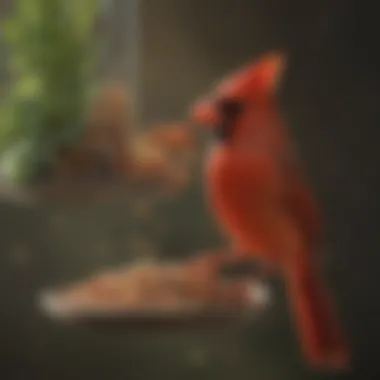
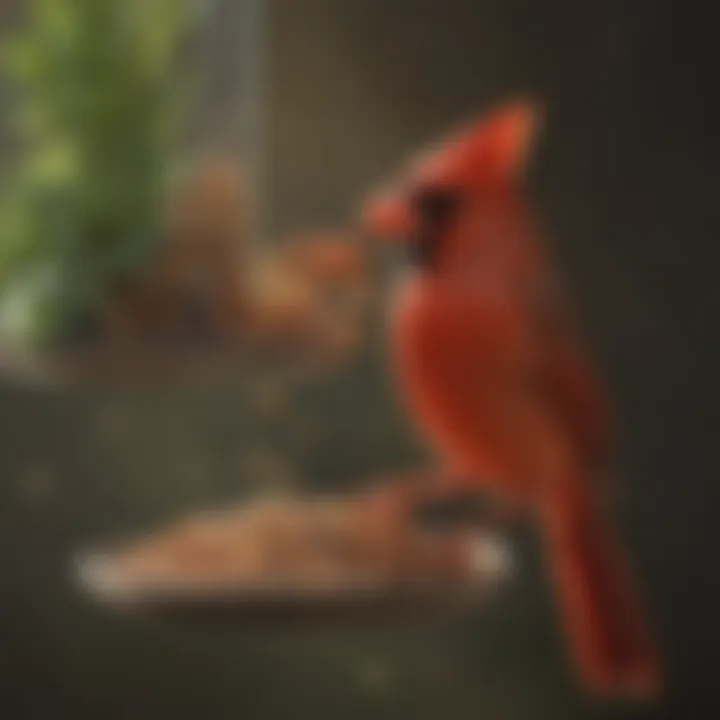
- Vital for tissue repair and growth.
- Found in insects, seeds, and specific plant material.
- Provide essential energy sources.
- Mainly acquired from fruits, berries, and seeds.
- Important for energy reserves.
- Rich sources include nuts and seeds.
- Support various bodily functions like immune health.
- Obtainable from a mix of fruits, greens, and seeds.
A well-rounded diet is essential for cardinals to maintain their vibrant plumage and energetic presence in their habitat.
In summary, a balanced nutrient profile is vital—without it, cardinals suffer from stunted growth and reduced reproductive success, impacting populations in specific ecosystems.
Daily Dietary Requirements
Upon digging deeper, one notices that cardinals need an estimated intake of different food sources. The daily intake varies by factors like season and age, but general guidelines can be indicated:
- Seeds:
- Fruits and Berries:
- Insects:
- Approximately 40% of its daily diet.
- Composing nearly 30% of what they consume.
- An important 30% during breeding seasons when protein is necessary for chicks.What Birds Do Cardinals like to eat?
Feeding habits can shift based on the time of year and energy requirements. In summation, slow changes happen throughout different times of the year.
Common Food Sources
Understanding the common food sources of the cardinal bird is crucial for grasping its specific dietary needs and how these reflect its natural habitat. Cardinals are granivores and omnivores, meaning their diet consists of seeds, nuts, fruits, berries, insects, and larvae. Their food preferences not only help maintain their health but also play a vital role in the ecosystem. The cardinal’s feeding habits aid in seed dispersal, which contributes to plant diversity in their environment.
Seeds and Nuts
Cardinals show a notable preference for seeds and nuts in their diet. Hard-shelled seeds, such as sunflower seeds, are particularly favored. The substantial fat content found in nuts provides the necessary energy that supports their active lifestyle, especially during colder months when food options are limited.
Insect and Larvae Consumption
Cardinal birds have a notable part of their diet that includes insects and larvae. Understanding the consumption of these food sources is crucial for assessing their overall nutrition and role in their ecosystem. This section delves into how and why cardinals forage for insects and larvae, the benefits these small protein-rich organisms provide, and the ecological considerations surrounding their consumption.
Importance of Protein
Protein plays a critical role in the development and survival of cardinal birds. Insects and larvae are highly dense in protein compared to seeds or fruits. This nutrient is essential for various physiological functions, including growth, feather development, and reproductive success. Young cardinals rely heavily on protein-rich diets as they grow, helping shape their emergence into robust adult birds.
The significance of protein extends to the maintenance of energy levels. During the breeding season, the demand for protein increases as both parents must provide enough nutrients to the chicks. The ability to quickly assimilate protein from insect sources can greatly enhance the survival chances of these young birds.
Insects like caterpillars, beetles, and ants hold additional advantages, serving not only as practical energy sources but also contributing trace minerals that are vital to the bird’s health. It is important to note that the demand for different proteins can shift throughout the seasons, reflecting changes in food availability.
Seasonal Insect Diet
Cardinal birds adjust their intake of insects and larvae based on seasonal availability. During spring and summer, the emergence of various insect populations aligns with the peak of cardinal nesting. Their diets during this time often consist of larger numbers of caterpillars and soft-bodied insects which are plentiful and easier to digest. Cardiands particularly favor these insects for their high moisture content, beneficial for hydration in warmer temperatures.
As the seasons transition to fall and winter, the diversity and availability of insects decline significantly. In these colder months, cardinals may increase their reliance on seeds and fats while still targeting available insect sources. They turn to dormant insect larvae and surprise themselves during warm spells when insects might surface.
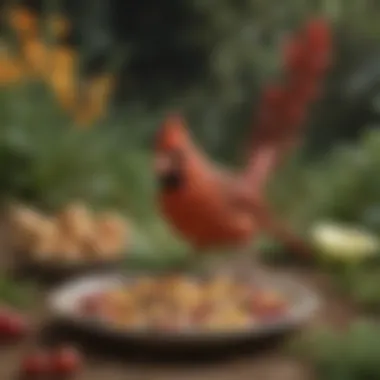

"Insects serve as a crucial dietary cornerstone, adjusting remarkably to both climate and life cycle of cardial birds."
Moreover, environmental changes can affect the patterns of insect populations, thus influencing seeking behavior in cardinals. A wetter season could indicate an abundant food source; however, a dry season could signify food scarcity, challenging their adaptability.
Through the study of their seasonal insect diet, one can appreciate how atmospheric conditions and their direct outcomes shape cardinal foraging behavior. This dynamic highlights the intricate link between the cardinal’s dietary habits and broader ecological conditions.
Feeding Behavior and Foraging Techniques
Feeding behavior and foraging techniques are crucial elements in understanding the dietary habits of cardinals. These birds exhibit unique ways of locating and consuming food that reflect their adaptability and resourcefulness in various environments. Such behaviors not only meet their nutritional requirements but also play a significant role in the ecosystems they inhabit.
Visual Cues for Food
Cardinals are highly visual creatures. Their excellent eyesight enables them to spot food from considerable distances. Color contrast is particularly important; bright colors signal ripe fruits or seeds. Structural composition of the terrain also helps them assess the viability of finding food, such as the openings in foliage. The red or orange hues of some foods become noticeable against the green growth of plants, influencing their decision on where to forage.
Moreover, cardinals are attracted to the movement. Active insects or seeds swaying in the breeze draw their attention. Birds tend to be strategic; they can memorize locations where food is plentiful based on successful past experiences, reinforcing a continuous loop of efficient foraging. Seasonal adjustments trigger differences in food visibility, requiring cardinals to adapt their foraging behaviors accordingly.
Foraging Strategies
Cardinals employ a variety of foraging strategies to maximize their feeding efficiency. They typically forage on the ground, carefully scratching and lifting debris to uncover hidden seeds or insects. Their strong beaks are adept at cracking open hard shells of nuts and seeds, showcasing their adaptability in food selection.
Interestingly, they also showcase social foraging. During periods of abundance, cardinals may feed in groups, which offers increased vigilance against predators. This communal behavior can lead to discovering new food spots more effectively. In contrast, during leaner seasons, they might adopt a more solitary foraging approach, focusing on areas where they can capitalize on fewer competitors.
Through these strategies, cardinals reflect an intrinsic connection to their environments and habitats. They indicate shifts in their feed sourcing based on what is seasonally available while balancing risk against foraging success. Maintaining such dietary preferences illustrates how the species can thrive in varied conditions while contributing to the local ecosystems they support.
Understanding how cardinals forage can enhance efforts in habitat conservation and biodiversity.
Seasonal Variations in Diet
Understanding the seasonal variations in the diet of cardinal birds is key to grasping their survival and overall behavior in different environments. These birds adapt their eating habits according to the changes in climate and food availability. In regions where winters are harsh, cardinals rely on specific food sources as they brace for cold months. Conversely, during warmer seasons, their diet diversifies to include various plants and insects. Studying these adaptations reveals how cardinals navigate the changing conditions effectively.
Winter Feeding Habits
During the winter, cardinal birds exhibit certain distinctive feeding habits that reflect the scarcity of food. As natural sources diminish, seeds become the primary resource capturing their interest. They primarily feed on seeds from plants such as sunflowers and various types of berries, which maintain their nutritious qualities throughout the colder months. Bird feeders filled with black oil sunflower seeds often draw cardinals closer to human habitats, providing them reliable nutrition this time of year.
In addition to seeds, cardinal birds also seek safe places to forage, often choosing environments shielded from strong winds. They exhibit opportunistic behavior, following local food sources and adapting based on food supply. Successful survival in winter often hinges on their ability to find adequate nutrition while avoiding danger from predators. Furthermore, storage is another crucial aspect—cardinals can store seeds to consume later, helping them make it through long periods without excessive foraging.
The Role of Cardinals in Ecosystems
The ecological contributions of the cardinal bird extend far beyond its vibrant coloring or melodious song. Understanding how cardinals fit within their natural environment illuminates their complexity and role in regulating ecological systems. This is relevant to our exploration of their dietary habits and overall behavior.
Seed Dispersal
Seed dispersal is crucial for plant reproduction and environmental regeneration. Cardinals, as granivorous birds, frequently consume a variety of seeds from plants such as sunflowers, pine trees, and dandelions. By ingesting these seeds and later excreting them, they facilitate new plant growth in untouched areas, promoting biodiversity.
This act of seed dispersal can have multiple benefits for ecosystems:
- Ecosystem Health: Promotes biotic richness and diversity, essential for robust ecosystems.
- Habitat Formation: New growth creates habitats for other wildlife, sustaining a complex network of life.
- Soil Improvement: Decaying waste integrates necessary nutrients back into the soil.


Interestingly, cardinals select particular seeds, which means they may influence the plant community composition, illustrating their significance in ecological networks. Their behavior when feeding, particularly in regards to seed choices, can shift native plant growth, thereby modeling their ecosystems.
“The simple act of eating can become a complex web of ecological responsibility.”
Predator and Prey Relationships
As both predators and prey, cardinals engage in a dynamic balance with their environment. While their primary role may lean towards that of a seed and insect consumer, their vulnerabilities remind us they are also food sources for various predatory birds and mammals. Examples of these predators include hawks, cats, and snakes, which rely on cardinals for sustenance when energy sources dwindle in their habitats.
Conversely, this predatory relationship shapes the behaviors cardinals adopt to safeguard themselves. Features like their bright red plumage serve dual purposes; they attract mates while being an asset in social behavior during foraging. This dynamic interplay exemplifies how cardinal birds alone maintain healthy animal and plant communities.
- Balance in Food Chains: Their presence indicates a thriving environment, exemplifying species interconnectedness.
- Opportunity for Research: Understanding the positions cardinals occupy in ecosystems provides vital clues for conservation efforts.
In summary, the roles cardinals play in ecosystem functioning showcase the interconnectedness of life forms. Their choices in diet and feeding habits not only sustain their species but also enhance the resilience and diversity of their habitats. This insight is invaluable for ecological preservation for future generations.
Conservation and Environmental Impact
The conservation and environmental impact surrounding cardinal birds are paramount themes within the context of their dietary habits. Declines in human-made habitats directly influence the diets of these birds, which in turn can substantially affect local ecosystems. Understanding this dynamic relationship is vital for both conservationists and local communities.
Impact of Habitat Loss
Habitat loss stands as one of the most significant threats to cardinal populations. Urbanization, agricultural development, and deforestation contribute markedly to diminishing their natural communities. As nesting sites and food sources decrease, cardinals may struggle to find enough to eat. With a reduction in food availability, not only the health of the individual birds is at risk, but also their reproductive success.
Consider the following effects:
- Decline in Species Richness: A loss of diverse plant species limits food sources like fruit and seeds, drastically affecting cardinal diets.
- Competitive Disadvantages: Reduced habitat may cause greater competition among bird species for remaining nutrient sources, which can disproportionately impact cardinals due to their specific feeding preferences.
- Commuting Distances: Increased distances between food sources may lead to higher energy expenditure for cardinals, ultimately impacting their overall health.
Research has indicated a direct connection between the amount of available habitat and the population health indicators of cardinals. As such, habitat conservation fosters greater biodiversity.
Significance of Bird Feeding
The importance of bird feeding initiatives has been recognized not just for maintaining cardinal populations but also in promoting ecological harmony. Supplemental feeding can alleviate some of the pressures that cardinals face during challenging times, such as extreme weather conditions or food shortages.
Key points for consideration regarding bird feeding include:
- Mid-Winter Food Sources: Providing food in colder months ensures cardinals continue to have nutritional access during scarce times.
- Contribution to Observation: Bird feeders allow enthusiasts to observe and learn more about cardinals' behavior and nutrition.
- Encouraging Biodiversity: When cardinals and other birds visit feeders, it promotes a interaction that supports richer ecological networks, cultivating community awareness.
Effective feeding practices not only keep cardinals nourished but also engage enthusiasts, fostering a culture of care for local wildlife.
By recognizing these elements, we can better devise strategies to conserve cardinal habitats and promote practices that enrich both bird diets and ecological systems. This reinforces the intricate connections that individual species have with each other and their shared environment.
The End
Understanding the dietary habits of cardinal birds is crucial for many reasons. First, it sheds light on their nutritional needs, which are intricate and vital for their health and reproductive success. Cardinals primarily rely on seeds, fruits, and insects to meet their dietary requirements. This diverse diet underscores the adaptability of the species and how they can thrive in various environments.
Next, recognizing the seasonal variations in their diet helps understand their behavior and habitat utilization. For example, in winter, cardinal birds often adjust their diets to include more seeds and less fruit, which is a reflection of available resources. In contrast, during warmer months, their diet broadens to include a larger quantity of insects and fruits.
Another key element is the ecological impact cardinals have through their dietary habits. As seed dispersers, they play an essential role in helping plants spread across their habitats. The interrelation of birds and their environments demonstrates the importance of bird conservation and providing appropriate habitats for them to thrive.
Moreover, exploring these dietary habits illustrates broader environmental considerations. Cardinal feeding patterns can serve as indicators of ecosystem health. If cardinals struggle to find food, it may suggest larger issues within their habitats.
Finally, there is a clear benefit to observing and understanding these behaviors for those enthusiastic about wildlife and ecology. It encourages responsible practices, like bird feeding, benefiting both avian populations and local biodiversity.
In essence, knowing about cardinal dietary habits enriches our understanding of ecological balance and can drive conservation efforts that maintain healthy ecosystems.
"Understanding the diet of a species can lead to proactive measures in conservation and habitat protection."







